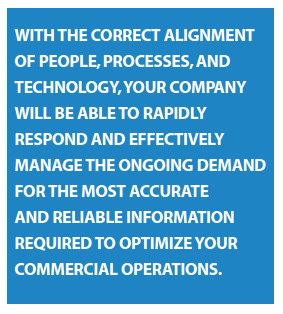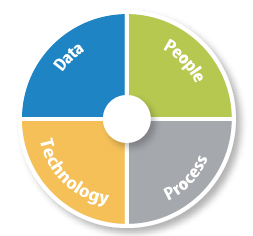 Managing key customer and product data effectively is critical to a pharmaceutical company’s ongoing commercial effectiveness as well as its compliance with FDA regulations and corporate initiatives. Customer data contain vital attributes for supporting various commercial business functions and systems including sales, marketing, commercial operations, contracting, clinical and compliance. Accurate data on healthcare providers (HCPs), healthcare organizations (HCOs), and healthcare accounts (HCAs) are critical to optimizing your commercial operations. An effective information management strategy will help you to:
Managing key customer and product data effectively is critical to a pharmaceutical company’s ongoing commercial effectiveness as well as its compliance with FDA regulations and corporate initiatives. Customer data contain vital attributes for supporting various commercial business functions and systems including sales, marketing, commercial operations, contracting, clinical and compliance. Accurate data on healthcare providers (HCPs), healthcare organizations (HCOs), and healthcare accounts (HCAs) are critical to optimizing your commercial operations. An effective information management strategy will help you to:
Monitor sales performance
Develop incentive compensation models
Implement effective personal and non-personal promotions
Provide accurate information to state and federal reporting organizations
Ensure compliant product sampling and sales details
Successful data management requires a thoughtfully planned and executed strategy that includes people, processes, and technology. There is no magic bullet driving change in the life-sciences industry; rather, myriad forces are converging to create a new environment for information management.
Economic Demands
The Affordable Care Act (ACA), one of the most comprehensive and transformational events in healthcare in decades, has resulted in the proliferation of Integrated Delivery Networks (IDNs) and Accountable Care Organizations (ACOs). Because these organizations use their own drug formularies, affiliation changes can affect providers’ prescribing patterns. The ACA also cuts Medicare reimbursement rates for approximately 700 hospitals with high infection rates, and this too can have an impact on healthcare provider behavior.
Insight into which hospitals and providers are affected by these changes allows life-sciences companies to identify the best ways to approach these institutions with new therapies that will drive positive patient outcomes.
Technology Influencers
 Today’s information management environment is limited by age-old practices that make accessing information slow and difficult. Although many organizations have built specialized technology solutions that solve specific problems, these solutions often leverage incompatible platforms and disconnected applications. Ultimately, they fail to deliver the comprehensive approach and detailed insights needed in today’s ever-changing healthcare environment. Life-sciences companies need to partner with vendors that can work in multiple technology environments and offer options for hosting and managing data on premise, in public clouds, or via hybrid-cloud services.
Today’s information management environment is limited by age-old practices that make accessing information slow and difficult. Although many organizations have built specialized technology solutions that solve specific problems, these solutions often leverage incompatible platforms and disconnected applications. Ultimately, they fail to deliver the comprehensive approach and detailed insights needed in today’s ever-changing healthcare environment. Life-sciences companies need to partner with vendors that can work in multiple technology environments and offer options for hosting and managing data on premise, in public clouds, or via hybrid-cloud services.
Interoperability
Most often data sets are stored in various formats, using different definitions and classification systems, in multiple and sometimes inflexible applications, on a variety of computing platforms.
Cloud Services
While no single cloud-based solution is a fit for all organizations, Amazon’s Web Services (AWS) public cloud, Virtual Private Networks (VPNs), and other private and on-premise hybrid models offer a range of scalable and flexible options for fast and easy computing.
Information Maintenance
The use and maintenance of a company’s data must be carefully monitored. This involves setting standards on data definitions, taxonomy, metrics, and measures, as well as developing policies and procedures for maintaining quality, handling discrepancies, and accessing the data.
Security
Data security goes beyond firewalls and passwords to include strategies that protect the data itself. Today’s security is enhanced by cloud providers with the financial and intellectual resources to deploy more robust measures than the average small or medium-sized organization.
 For example, a robust universal data management approach employs a range of permission-based protections to limit file access to those who need it. A case can be made that this permission-based approach may help defend confidential data (by warehousing it in one place rather than multiple locations with multiple attack pathways). Meanwhile, it ensures that qualified users have dynamic access to the data and information they need to make informed decisions.
For example, a robust universal data management approach employs a range of permission-based protections to limit file access to those who need it. A case can be made that this permission-based approach may help defend confidential data (by warehousing it in one place rather than multiple locations with multiple attack pathways). Meanwhile, it ensures that qualified users have dynamic access to the data and information they need to make informed decisions.
Business Drivers
New sales and marketing strategies have also emerged. For these critical business functions, success is often determined by how well a company can accommodate rapid changes in regulations and new and flexible information delivery systems.
Companies are implementing Customer Relationship Management (CRM) solutions to manage their relationships, contacts, and territories. Marketing groups are adopting omnichannel marketing practices to improve ROI on campaigns and customer engagements. Often these applications are not connected and end up creating multiple client records that must be managed to ensure accurate reporting.
Consider, for example, your current contact lists. As providers join IDNs or retire from practice, their contact information changes. In most cases, current methods for managing contact changes are not completely harmonized, resulting in a variety of conflicting addresses and phone numbers across applications. A robust Master Data Management (MDM) solution will reconcile these discrepancies, ensuring that the most up-to-date information is available across the enterprise.
Key Factors for Information Management Success
The following key success factors are vital if your company wants to accelerate data integration and understand data sources from disparate applications and systems:
Invest in a strong data governance and data quality program. Reporting and data sharing across your enterprise can quickly become unmanageable without a clearly articulated data quality policy.
Develop the solution framework. Work with key stakeholders who understand the data at a micro-level, are intimately familiar with the industry, and have a proven healthcare background.
Entrust the daily work to professionals who specialize in information management. Making decisions on the disposition of individual master records often involves the painstaking process of tracing a record back to the originating source(s), such as a state licensing board. It also entails making judgment calls on the disposition of entries, for example, to determine what specialty a customer should be listed under for promotional purposes or to identify which address should be used for personal or non-personal promotion.
Perform an annual audit to confirm the core data attributes remain aligned to the defined business definition and are meeting the established data quality standards. Ideally, a company’s data are benchmarked against industry data to identify gaps and inconsistencies. Using a syndicated source of information removes the bias that may be perceived from using an internal source.
Align solutions and strategies with the evolving business definitions and requirements. For example, for the customer domain, the system should be able to capture and manage new sources of information — whether derived or purchased — on ACOs, IDNs, payers, plan affiliations, and channel preferences (Opt in/Out) as well as their associated constraints. The solution should take into account both the technical ability to store and manage data as well as the business strategy to capture and utilize the information.
Ensure executive sponsorship and organizational change management. The enterprise-wide adoption of an effective information management program is paramount to achieving organizational adoption and the success of the overall program.
Preparing for the Era of Big Data
As we continue the journey into the era of Big Data, attitudinal and social media data will become more and more available for pharmaceutical organizations via CRM, sales force interactions and web site usage and applications like Facebook, LinkedIn, etc. However, it is not yet clear what type of information may be used for analytics, let alone the compliance and marketing constraints that may be enforced. Such data can certainly be used to help define audience segments and refine messages.
Information Management-as-a-Service
Information management must bring together both analytical and operational data in a flexible, scalable environment to deliver actionable insights. It also must provide the ability to track new campaigns, measure ROI, and adapt to changing market conditions.
As customers prepare for the Internet of Things, investments in integration, standardization, and interoperability are of paramount importance.
With an eye toward the future, companies should strive for a single integrated information management solution that supports their operational needs. A platform built in the cloud allows the information model to be extended as new sources are identified and additional applications and processes integrated into the framework. It is a shared, cost-effective platform that is interoperable with third-party data and applications as well as changing internal business processes. Such a platform provides value to an organization from centralized control, improved data quality, and very manageable change management options.
With the correct alignment of people, processes, and technology your company will be able to rapidly respond and effectively manage the ongoing demand for the most accurate and reliable information required to optimize your commercial operations. (PV)
IMS Health is a leading global information and technology services company providing clients in the healthcare industry with comprehensive solutions to measure and improve their performance. The company’s end-to-end proprietary applications and configurable solutions connect complex healthcare data through its cloud-based master data management platform, providing comprehensive insights into diseases, treatments, costs, and outcomes.
For more information, visit www.imshealth.com/MDM.


















